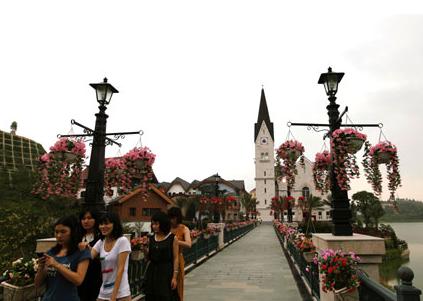Clone of Austrian village wins acceptance
A US$940 million Chinese clone of one of Austria's most picturesque villages, the UNESCO World Heritage-listed Hallstatt, has opened its doors to visitors in the southern Chinese province of Guangdong amidst some controversy.
 |
|
Women walk at the Chinese replica of Austria's UNESCO heritage site, Hallstatt Village in China's southern city of Huizhou in Guangdong Province June 2, 2012. |
The "Made in China" version of the lakeside European village known for tourism and salt includes an exact replica of its church clock tower, European style wooden houses and other properties that will be sold to investors.
The project, conceived by a Chinese mining tycoon, initially sparked outrage and surprise among some Hallstatt villagers, who weren't at first aware of the attempt to copy their unique, centuries-old home.
Half an hour's ride away from the gritty city of Huizhou, China's Hallstatt hopes to become a new tourist attraction. Disney-themed photo spots are scattered around the village's main plaza, which is modeled after Hallstatt's marketplace.
"The moment I stepped into here, I felt I was in Europe," said 22-year-old Zhu Bin, a Huizhou resident. "The security guards wear nice costumes. All the houses are built in European style."
Taking up 1 million square meters, cranes and construction sites spread across barren hills above the gabled houses, promising an expansion of the current town.
Despite the initial mixed response, local authorities in Hallstatt have since softened their stance, seeing a rare, marketing opportunity at the heart of one of the world's fastest growing tourism markets.
"It was not so controversial. We were only surprised that a small village in Austria was built, and now we are very proud that it happened," said Hallstatt's Mayor Alexander Scheutz, who flew with an Austrian delegation to mark the official opening and signed documents promising future cultural ties.
Visitors and journalists filming on site last Friday were asked to leave shortly before Scheutz's unannounced visit.
The director of tourism for Hallstatt, Pamela Binder, said Hallstatt had made peace with its Chinese replica. "First we were a bit insecure. Why did it come to replicate Hallstatt, and then we became lucky and proud," Binder said.
Fewer than 50 Chinese tourists visited Hallstatt in 2005, but now thousands fly to the Austrian town every year, according to officials from the Austrian delegation in China.

